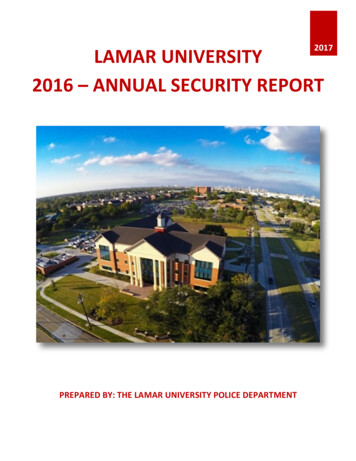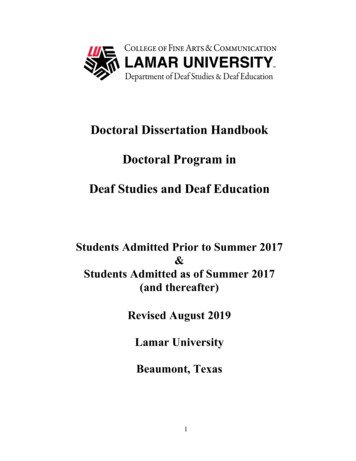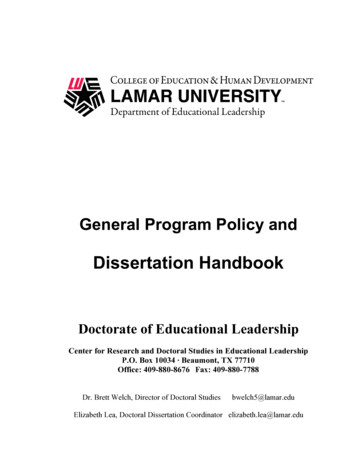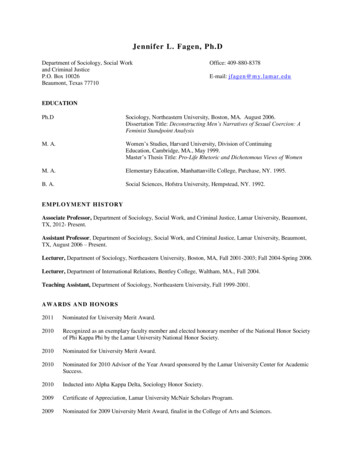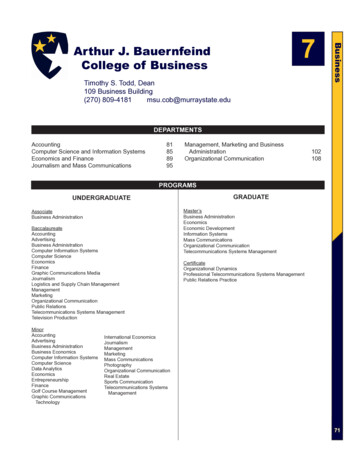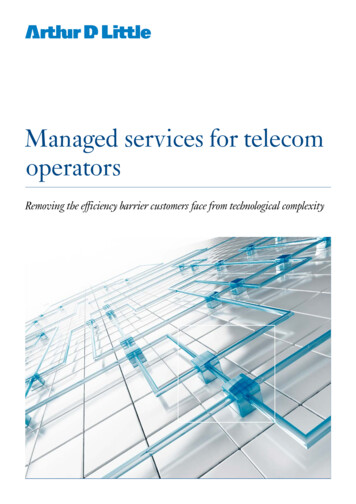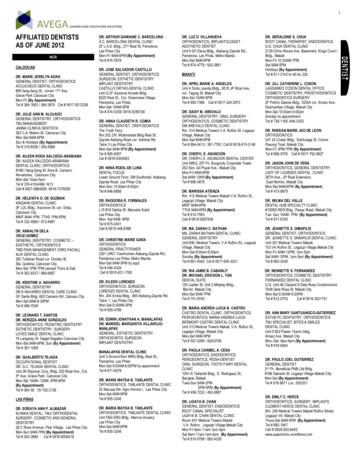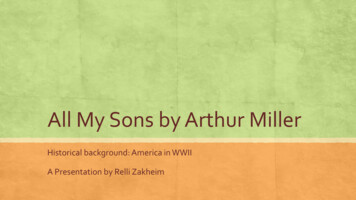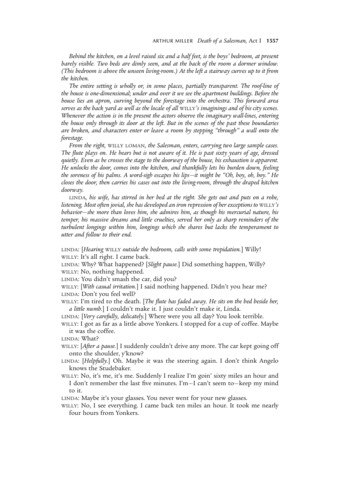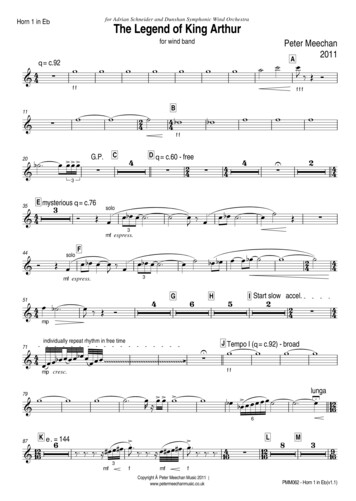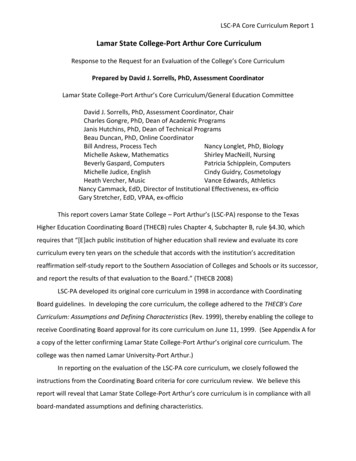
Transcription
LSC-PA Core Curriculum Report 1Lamar State College-Port Arthur Core CurriculumResponse to the Request for an Evaluation of the College’s Core CurriculumPrepared by David J. Sorrells, PhD, Assessment CoordinatorLamar State College-Port Arthur’s Core Curriculum/General Education CommitteeDavid J. Sorrells, PhD, Assessment Coordinator, ChairCharles Gongre, PhD, Dean of Academic ProgramsJanis Hutchins, PhD, Dean of Technical ProgramsBeau Duncan, PhD, Online CoordinatorBill Andress, Process TechNancy Longlet, PhD, BiologyMichelle Askew, MathematicsShirley MacNeill, NursingBeverly Gaspard, ComputersPatricia Schipplein, ComputersMichelle Judice, EnglishCindy Guidry, CosmetologyHeath Vercher, MusicVance Edwards, AthleticsNancy Cammack, EdD, Director of Institutional Effectiveness, ex-officioGary Stretcher, EdD, VPAA, ex-officioThis report covers Lamar State College – Port Arthur’s (LSC-PA) response to the TexasHigher Education Coordinating Board (THECB) rules Chapter 4, Subchapter B, rule §4.30, whichrequires that “*E ach public institution of higher education shall review and evaluate its corecurriculum every ten years on the schedule that accords with the institution’s accreditationreaffirmation self-study report to the Southern Association of Colleges and Schools or its successor,and report the results of that evaluation to the Board.” (THECB 2008)LSC-PA developed its original core curriculum in 1998 in accordance with CoordinatingBoard guidelines. In developing the core curriculum, the college adhered to the THECB’s CoreCurriculum: Assumptions and Defining Characteristics (Rev. 1999), thereby enabling the college toreceive Coordinating Board approval for its core curriculum on June 11, 1999. (See Appendix A fora copy of the letter confirming Lamar State College-Port Arthur’s original core curriculum. Thecollege was then named Lamar University-Port Arthur.)In reporting on the evaluation of the LSC-PA core curriculum, we closely followed theinstructions from the Coordinating Board criteria for core curriculum review. We believe thisreport will reveal that Lamar State College-Port Arthur’s core curriculum is in compliance with allboard-mandated assumptions and defining characteristics.
LSC-PA Core Curriculum Report 2Table of ContentsIntroductionRequired Element 1:LSC-PA’s Core Curriculum,Exemplary Educational Objectives, and Common Course Numbers . . . . . . . . . . . . . . . . . . . . . . . . . 3Lamar State College-Port Arthur Core Curriculum& THECB Component Areas and Common Course Numbering . . . . . . . . . . . . . . . . . . . . . . . . 21Required Element Two:A Brief Description of the Purpose and Substance ofLamar State College-Port Arthur’s Core Curriculum . . . . . . . . . . . . . . . . . . . . . . . . . . . . . . . . . . . . . 24Required Element Three:A Description of the Processes and ProceduresUsed to Evaluate LSC-PA’s Core Curriculum . . . . . . . . . . . . . . . . . . . . . . . . . . . . . . . . . . . . . . . . . . . .28Required Element Four:A Description of the Ways in Which the Evaluation Results Are BeingOr Will Be Used To Improve the Core Curriculum at Lamar State College-Port Arthur . . . . . . . . . 30AppendicesAppendix A: Letter from THECB Approving LSC-PA’s Original Core Curriculum . . . . . . . . . . . . . . . . 31Appendix B: Draft Copies of Exemplary Educational Objectives Tables . . . . . . . . . . . . . . . . . . . . . . .32Appendix C: Spring 2011 Assessment Findings for Associate of Arts . . . . . . . . . . . . . . . . . . . . . . . . . 80
LSC-PA Core Curriculum Report 3Required Element 1: LSC-PA’s Core Curriculum,Exemplary Educational Objectives, and Common Course NumbersThe following tables include representative samples of how LSC-PA’s core curriculum coursescomply with the core component areas and exemplary educational objectives provided by THECB.COMMUNICATIONThe objective of a communication component of a core curriculum is to enable the studentto communicate effectively in clear and correct prose in a style appropriate to the subject,occasion, and audience. The communication component of LSC-PA’s core curriculum is comprisedof two courses in composition (ENGL 1301 and ENGL 1302), and a choice from two courses inspeech communication (SPCH 1315 Public Speaking or SPCH 2335 Argumentation & Debate).Representative student learning outcomes consequent of the exemplary educational objectives forthe communications component recommended by THECB are presented below:Table 1: Exemplary Educational Objectives and Representative Student Learning Outcomes forCommunication Core CoursesEXEMPLARYEDUCATIONALOBJECTIVES1. To understand anddemonstrate writing andspeaking processesthrough invention,organization, drafting,revision, editing, andpresentation. 2. To understand theimportance of specifyingaudience and purpose andto select appropriatecommunication choices.Representative SLOs for SpeechCoursesRepresentative SLOs for EnglishCourses Demonstrate the ability togenerate ideas.Invent, plan, and revise text.Write a documented researchpaper. Demonstrate the speakingprocess through invention,organization, drafting, revision,and presenting oral presentation.Identify appropriate audience andpurpose of assignment.Make appropriate choicesregarding audience, purpose, andgenre. Use appropriate choices regardingaudience analysis and selectpurposes for communicatinginformation.
LSC-PA Core Curriculum Report 4EXEMPLARYEDUCATIONALOBJECTIVES3. To understand andappropriately applymodes of expression, i.e.,descriptive, expositive,narrative, scientific, andself-expressive, in written,visual, and oralcommunication.4. To participateeffectively in groups withemphasis on listening,critical and reflectivethinking, and responding.5. To understand andapply basic principles ofcritical thinking, problemsolving, and technicalproficiency in thedevelopment ofexposition and argument.6. To develop the abilityto research and write adocumented paper and/orto give an oralpresentation.Representative SLOs for SpeechCoursesRepresentative SLOs for EnglishCourses Build on expository skills todevelop the body of adocumented research paper.Write an essay that is based onthe appropriate mode ofdevelopment.Write effectively for particularcontexts and rhetorical situations.Work in groups effectively.Participate in peer editing andoffer and receive constructivepeer criticism. Create and perform presentationswhich appropriately apply therequired modes of expression. Participate in group activitieswhich emphasize listening, criticalthinking skills, and responding. Create and perform oralpresentations which demonstratethe basic principles of criticalthinking, problem solving, and/ortechnical proficiency in thedevelopment of exposition,argument, and debate. Demonstrate use of research skillsthrough documentation ofsources in oral presentations.Write an argumentative thesisstatement and complete anargumentative essay.Write a variety of analyticalessays.Write a documented researchpaper.Submit a library project requiringdocumentation.
LSC-PA Core Curriculum Report 5MATHEMATICSThe objective of the mathematics component of the core curriculum is to develop aquantitatively literate college graduate. Every college graduate should be able to apply basicmathematical tools in the solution of real-world problems. LSC-PA’s core curriculum requires 3hours of mathematics. Students can choose from MATH 1314 College Algebra, MATH 1324Mathematics for Business Applications, or MATH 1332 College Mathematics I. Representativestudent learning outcomes consequent of the exemplary educational objectives for themathematics component recommended by THECB are presented below:Table 2: Exemplary Educational Objectives and Representative Student Learning Outcomes forMathematics Core CoursesEXEMPLARYEDUCATIONALOBJECTIVES1. To apply arithmetic,algebraic, geometric,higher-order thinking,and statisticalmethods to modelingand solving real-worldsituations.2. To represent andevaluate basicmathematicalinformation verbally,numerically,graphically, andsymbolically.3. To expandmathematicalreasoning skills andformal logic todevelop convincingmathematicalarguments.Representative SLOs for Math Courses Apply quantitative reasoning in practical situations. Solve mathematical problems with information presented in various ways. Apply algebraic problem solving skills.Employ algebraic and geometric problem solving skills.
LSC-PA Core Curriculum Report 6EXEMPLARYEDUCATIONALOBJECTIVES4. To use appropriatetechnology to enhancemathematical thinkingand understanding andto solve mathematicalproblems and judgethe reasonableness ofthe results.5. To interpretmathematical modelssuch as formulas,graphs, tables andschematics, and drawinferences from them.6. To recognize thelimitations ofmathematical andstatistical models.7. To develop the viewthat mathematics is anevolving discipline,interrelated withhuman culture, andunderstand itsconnections to otherdisciplines.Representative SLOs for Math Courses Use appropriate technology for solving problems. Recognize and interpret data in different model forms to draw inferences and applyformulas.Interpret and use formulas, graphs, and tables to solve mathematical problems. Realize not all data is sufficient or valuable. Use algebra as the basic vocabulary of mathematics.Convert number formats among various numerical systems.
LSC-PA Core Curriculum Report 7NATURAL SCIENCESThe objective of the study of a natural sciences component of a core curriculum is to enablethe student to understand, construct, and evaluate relationships in the natural sciences, and toenable the student to understand the bases for building and testing theories. The 8-hour naturalsciences component of LSC-PA’s core curriculum can be satisfied by selecting courses from BIOL1406 General Biology I, BIOL 1407 General Biology II, BIOL 2401 Human Anatomy and Physiology I,BIOL 2402 Human Anatomy and Physiology II, CHEM 1405 Introductory Chemistry, CHEM 1406Chemistry for Allied Health Science, CHEM 1407 Introductory Chemistry, CHEM 1408 Biochemistryfor Allied Health Science, CHEM 1411 General Chemistry, CHEM 1412 General Chemistry, GEOL1403 Physical Geology, GEOL 1404 Physical Geology, PHYS 1401 General Physics I, PHYS 1402General Physics II, PHYS 1405 Conceptual Physics, PHYS 1407 Conceptual Physics, PHYS 1415Physical Science I, PHYS 1417 Physical Science II, PHYS 2425 Calculus Based Physics I, and PHYS2426 Calculus Based Physics II. All natural science courses include both lecture and labexperiences. Representative student learning outcomes in line with the exemplary educationalobjectives for the natural sciences component recommended by THECB are presented below:Table 3: Exemplary Educational Objectives and Representative Student Learning Outcomes forNatural Sciences Core e SLOsfor Biology Courses1. To understand and applymethod and appropriatetechnology to the study ofnatural sciences. Identify and labelparts of the humananatomy.2. To recognize scientificand quantitative methodsand the differencesbetween these approachesand other methods ofinquiry and tocommunicate findings,analyses, andinterpretation both orally Identify applications ofbiological principles tounderstand theanatomy of the humanbody down to thecellular level.Representative SLOsfor Physics Courses Apply the principles,definitions, andequations to describephysical phenomena. Identify the correctprinciples andequations required tosolve problems.Representative SLOsfor Chemistry Courses Use scientificlaboratory equipmentand analyticaltechniques toinvestigate variouschemical phenomena. Identify application ofchemical principles toeveryday life.
LSC-PA Core Curriculum Report 8EXEMPLARYEDUCATIONALOBJECTIVESRepresentative SLOsfor Biology CoursesRepresentative SLOsfor Physics CoursesRepresentative SLOsfor Chemistry Courses Learn the theories ofevolution of man bycomparative anatomy. Evaluate theoriesusing principles ofphysics. Test hypotheses ofchemical phenomena. Apply biologicalprocesses to health,nutrition, andreproductive issues. Review the principlesof physics and applythem to major socialproblems. Discuss basic chemicalprinciples and theirsignificance toscience. Demonstrateunderstanding ofphysical principlesthat make moderntechnology possible,including theirboundaries andlimitations in ourmodern culture. Describe applicationof chemistry ineveryday life andindustry.and in writing.3. To identify and recognizethe differences amongcompeting scientifictheories.4. To demonstrateknowledge of the majorissues and problems facingmodern science, includingissues that touch uponethics, values, and publicpolicies.5. To demonstrateknowledge of theinterdependence of scienceand technology and theirinfluence on, andcontribution to, modernculture.
LSC-PA Core Curriculum Report 9HUMANITIES AND VISUAL & PERFORMING ARTSThe objective of the humanities and visual and performing arts in a core curriculum is toexpand students' knowledge of the human condition and human cultures, especially in relation tobehaviors, ideas, and values expressed in works of human imagination and thought. Through studyin disciplines such as literature, philosophy, and the visual and performing arts, students willengage in critical analysis, form aesthetic judgments, and develop an appreciation of the arts andhumanities as fundamental to the health and survival of any society. Students should haveexperiences in both the arts and humanities.This 9-hour component of the college’s core curriculum can be satisfied by courses in 5disciplines. Students must complete one sophomore-level literature course to satisfy 3 hours ofthe requirement, chosen from ENGL 2321 Masterpieces of British Literature, ENGL 2326Masterpieces of American Literature, ENGL 2331 Masterpieces of World Literature, or ENGL 2341Forms of Literature. The remaining 6 hours may be completed by taking an additional sophomorelevel literature, or by any combination of the following: HUMA 1315 Appreciation of the Arts andHumanities, PHIL 1301 Introduction to Philosophy, PHIL 1304 Introduction to World Religions, PHIL1316 History of Religions I, PHIL 1317 History of Religions II, PHIL 2303 Logic and Ethics, ARTS 1301Art Appreciation, ARTS 1303 Art History I, ARTS 1304 Art History II, ARTS 1311 Design I, ARTS 1316Drawing I, DRAM 1310 Introduction to Theater, DRAM 1320 Theater Practicum I, DRAM 1321Theater Practicum II, DRAM 1330 Stagecraft I, DRAM 1351 Acting I: Fundamentals, DRAM 1352Acting II: Stage Movement, DRAM 2336 Voice for the Theater, DRAM 2351 Acting III, DRAM 2361History of the Theater I, MUSI 1306 Music Appreciation, or MUSI 1310 American Popular Music.Representative student learning outcomes consequent of the exemplary educational objectives forthe Humanities and Visual & Performing Arts component recommended by THECB are presentedbelow:Table 4: Exemplary Educational Objectives and Representative Student Learning Outcomes forHumanities and Visual & Performing Arts Core e SLOsforEnglish CoursesRepresentative SLOsforArt CoursesRepresentative SLOsforTheater Courses
LSC-PA Core Curriculum Report 10EXEMPLARYEDUCATIONALOBJECTIVESRepresentative SLOsforEnglish CoursesRepresentative SLOsforArt CoursesRepresentative SLOsforTheater Courses 1. To demonstrateawareness of the scope andvariety of works in the artsand humanities. Study works fromacross the world andacross the ages. See and read objectsaround them withaccuracy.Interpret and applydesign principles.Interpret diverse viewsexpressed through art. 2. To understand thoseworks as expressions ofindividual and humanvalues within an historicaland social context.3. To respond critically toworks in the arts andhumanities. Relate the historicaland social context ofliterature.Write critically andcogently in responseto the literature. Recognize culturaldiversity expressedthrough art. Recognize anddistinguish works ofart and periods of artcreation.Recognize andevaluate effectivedesign.Demonstrateunderstanding ofworks of art and theevolution of art. 4. To engage in thecreative process orinterpretive performanceand comprehend thephysical and intellectualdemands required of theauthor or visual orperforming artist. Read literature aloud,with attention todialect, tone, andgenre. Experience thephysical andintellectual rigor toproduce art.Experience thephysical andintellectual rigor toproduce effectivedesign. Recognize and definecharacteristics of thefunctions of actor,director, costumer,scene designer, andlight designer, as wellas other theater termsand concepts,including technicaltheater.Create a characterthrough lines of dialogand physical actions topresent in publicperformance.Identify specifichistorical trends intheater production.Research and interpretthe values of acharacter withinhistorical and socialcontexts.Use critical thinking inanalysis of dramaticscript or performance,in both written andoral form.Interpret and respondto analysis of variousplaywrights’ worksand the characters inthose works.Participate in adramatic scene inwhich each studentcontributes dialog tothe script andmonologperformance.Perform monologs andaudition materials inclass and publicperformance.
LSC-PA Core Curriculum Report 11EXEMPLARYEDUCATIONALOBJECTIVESRepresentative SLOsforEnglish CoursesRepresentative SLOsforArt CoursesRepresentative SLOsforTheater Courses 5. To articulate aninformed personal reactionto works in the arts andhumanities. Write both formal andinformal responses tothe literature. Interpret works of artcritically.Interpret design andits principles critically.Identify major stylesand artists. 6. To develop anappreciation for theaesthetic principles thatguide or govern thehumanities and arts. Make judgmentsabout the estheticqualities of texts. 7. To demonstrateknowledge of the influenceof literature, philosophy,and/or the arts onintercultural experiences. Identify elements ofnew historicalcriticism. Judge art and its effortcritically.Demonstrateappreciation of thevalue of the visual artsand their importancethrough history.Demonstrate anunderstanding ofdesign as an integralpart of life.Integrate art intoother disciplines andinto life itself. Describe the rehearsalprocess andperformanceexperience in a selfreflective performanceresponse analysis.Articulate an informedpersonal reaction tothe performance of arole.Demonstrateknowledge andappreciation ofproduction elements.Identify, respond to,and create differentstyles of theatricalexpression based onthe requirements ofthe character andplay.Think critically toanalyze a dramaticscript or performance.Identify culturallydiverse characters andsituations relevant tothe play.
LSC-PA Core Curriculum Report 12EXEMPLARY EDUCATIONALOBJECTIVES1. To demonstrate awareness ofthe scope and variety of works inthe arts and humanities.2. To understand those works asexpressions of individual andhuman values within an historicaland social context.3. To respond critically to works inthe arts and humanities.Representative SLOs forPhilosophy Courses Demonstrate understanding ofthe synoptic perspective. Demonstrate a knowledge ofthe evolution of philosophy. Evaluate schools ofphilosophy.4. To engage in the creativeprocess or interpretiveperformance and comprehend thephysical and intellectual demandsrequired of the author or visual orperforming artist.5. To articulate an informedpersonal reaction to works in thearts and humanities.6. To develop an appreciation forthe aesthetic principles that guideor govern the humanities and arts.7. To demonstrate knowledge ofthe influence of literature,philosophy, and/or the arts onintercultural experiences. Analyze various ontologies. Demonstrate acomprehension ofphilosophical concepts. Analyze diverse philosophicaltraditions.Representative SLOs forMusic Courses Identify the characteristics ofdifferent musical genres. Identify the relationshipbetween significant histo
Nancy Cammack, EdD, Director of Institutional Effectiveness, ex-officio Gary Stretcher, EdD, VPAA, ex-officio This report covers Lamar State College – Port Arthur’s (LS-PA) response to the Texas Higher Education Coordinating Board (THECB) rules Chapter 4, Subchapter B, rule §4.30, which
